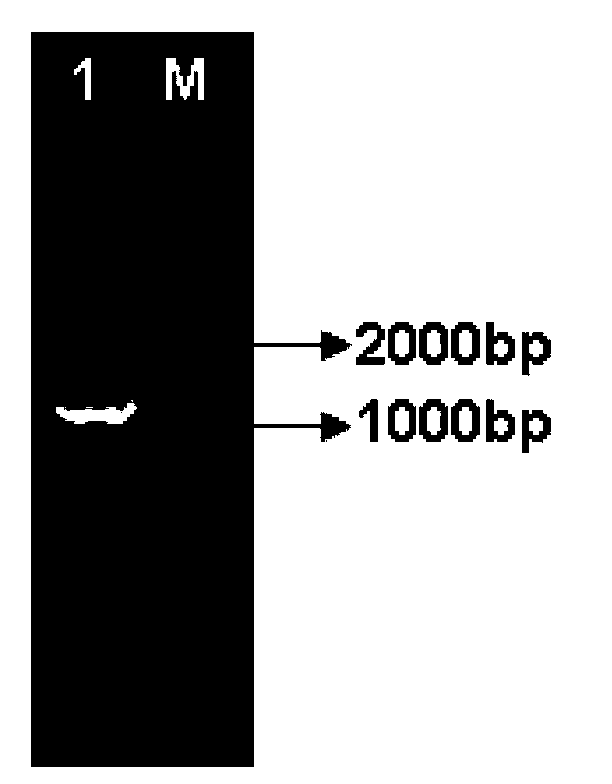Transcription factor coming from leymus chinensis and related to low temperature resistance, and coding gene and application thereof
A coding and gene technology, applied in application, genetic engineering, plant genetic improvement, etc., can solve problems such as difficulty in plant drought resistance and complex plant stress resistance traits.
- Summary
- Abstract
- Description
- Claims
- Application Information
AI Technical Summary
Problems solved by technology
Method used
Image
Examples
Embodiment 1
[0072] Example 1. Obtaining the gene LcWRKY3 related to plant low temperature tolerance
[0073] 1. Plant material processing and total RNA extraction
[0074] The seedlings of Leymus chinensis (Trin.) variety Jisheng No. 1 (Jisheng Leymus chinensis seedling station in Jilin Province) were used as materials, and total RNA was extracted after 6 hours and 12 hours treatment at 4°C, and detected by 1% agarose gel electrophoresis. , The result is figure 1 Shown. The extracted RNA has two obvious electrophoresis bands, 28S RNA and 18SRNA from top to bottom, indicating that a more pure and complete total RNA was obtained.
[0075] 2. Obtaining and PCR detection of the full-length cDNA sequence of the gene LcWRKY3 related to plant low temperature tolerance
[0076] The 3'-end sequence of the gene LcWRKY3, which is related to plant low temperature tolerance, was obtained by sequencing in our laboratory. BLAST alignment was performed on the NCBI with the obtained 3'-end cDNA sequence of the ...
Embodiment 2
[0080] Example 2. Bioinformatics analysis of LcWRKY3 and its encoded protein
[0081] 1. Sequence analysis of LcWRKY3 gene and prediction of structure and function of the encoded protein
[0082] Using DNAMAN and DNAstar software, the full-length cDNA sequence of LcWRKY3 obtained in Example 1 was analyzed by bioinformatics, and the protein LcWRKY3 was encoded by 338 amino acid residues. It is estimated that its molecular weight is 35.511kDa, and its isoelectric point PI value is 9.752. The online Blast tool (http: / / blast.ncbi.nlm.nih.gov / Blast.cgi) was used to analyze the domain of LcWRKY3, and the results showed that the sequence of LcWRKY3 between amino acid residues 270-330 is a conservative WRKY DNA binding domain, the sequence between amino acid residues 221-227 is a possible nuclear localization signal PRRRCSG. This indicates that the protein is a member of the WRKY transcription factor superfamily.
[0083] 2. The homology and phylogenetic tree analysis of the amino acid se...
Embodiment 3
[0085] Example 3. Analysis of expression pattern and tissue specific expression of LcWRKY3 under different abiotic stress and hormone treatment conditions
[0086] 1. The expression pattern analysis of LcWRKY3 under different abiotic stress and hormone treatment conditions
[0087] The seedlings of Leymus chinensis (Jisheng No.1, Jisheng Leymus chinensis Fine Breeding Station, Jilin Province) which had been grown normally for 9 weeks were subjected to different abiotic stress: 400mM NaCl, 42℃ high temperature, 4℃ for 6 hours and different hormones: 100μM 6-benzyl adenine (BAP), 100μM salicylic acid (SA), 100μM methyl jasmonate (MJ), 100μM gibberellin (GA), 100μM abscisic acid (ABA) for 6 hours. The total RNA of Leymus chinensis seedlings was extracted separately, using LcWRKY3 gene primers (upstream primer: 5'-AAGCTGGTCCAGCCATTGTC-3' (sequence 2 370-389); downstream primer: 5'-CGTCCTCTTCACCCGCAAC-3' (sequence 2 reverse complementary sequence of positions 750-768)) with Actin gene ...
PUM
| Property | Measurement | Unit |
|---|---|---|
| molecular weight | aaaaa | aaaaa |
Abstract
Description
Claims
Application Information
 Login to View More
Login to View More - R&D
- Intellectual Property
- Life Sciences
- Materials
- Tech Scout
- Unparalleled Data Quality
- Higher Quality Content
- 60% Fewer Hallucinations
Browse by: Latest US Patents, China's latest patents, Technical Efficacy Thesaurus, Application Domain, Technology Topic, Popular Technical Reports.
© 2025 PatSnap. All rights reserved.Legal|Privacy policy|Modern Slavery Act Transparency Statement|Sitemap|About US| Contact US: help@patsnap.com



